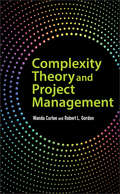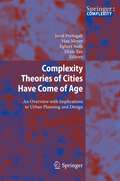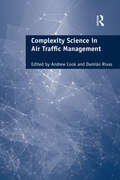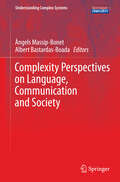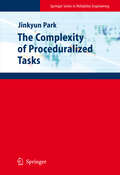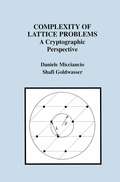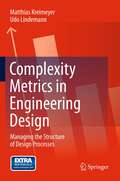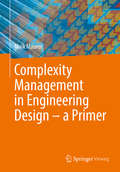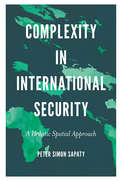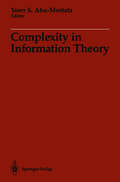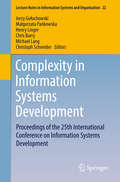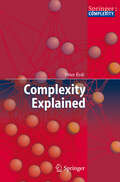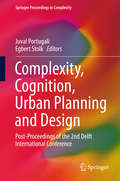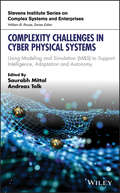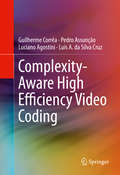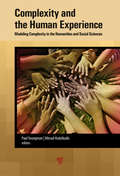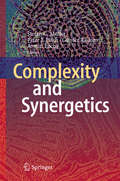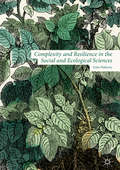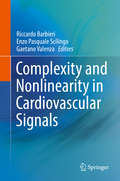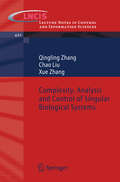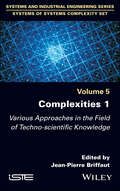- Table View
- List View
Complexity Theory and Project Management
by Wanda Curlee Robert L. GordonAn insightful view on how to use the power of complexity theory to manage projects more successfully Current management practices require adherence to rigid, global responses unsuitable for addressing the changing needs of most projects. Complexity Theory and Project Management shifts this paradigm to create opportunities for expanding the decision-making process in ways that promote flexibility—and increase effectiveness. It informs readers on the managerial challenges of juggling project requirements, and offers them a clear roadmap on how to revise perspectives and reassess priorities to excel despite having an unpredictable workflow. One of the first books covering the subject of complexity theory for project management, this useful guide: Explains the relationship of complexity theory to virtual project management Supplies techniques, tips, and suggestions for building effective and successful teams in the virtual environment Presents current information about best practices and relevant proactive tools Makes a strong case for including complexity theory in PMI®'s PMBOK® Guide Complexity Theory and Project Management gives a firsthand view on the future of complexity theory as a driving force in the management field, and allows project managers to get a head start in applying its principles immediately to produce more favorable outcomes. (PMI and PMBOK are registered marks of the Project Management Institute, Inc.)
Complexity Theories of Cities Have Come of Age: An Overview with Implications to Urban Planning and Design
by Juval Portugali, Han Meyer, Egbert Stolk and Ekim TanToday, our cities are an embodiment of the complex, historical evolution of knowledge, desires and technology. Our planned and designed activities co-evolve with our aspirations, mediated by the existing technologies and social structures. The city represents the accretion and accumulation of successive layers of collective activity, structuring and being structured by other, increasingly distant cities, reaching now right around the globe.This historical and structural development cannot therefore be understood or captured by any set of fixed quantitative relations. Structural changes imply that the patterns of growth, and their underlying reasons change over time, and therefore that any attempt to control the morphology of cities and their patterns of flow by means of planning and design, must be dynamical, based on the mechanisms that drive the changes occurring at a given moment.This carefully edited post-proceedings volume gathers a snapshot view by leading researchers in field, of current complexity theories of cities. In it, the achievements, criticisms and potentials yet to be realized are reviewed and the implications to planning and urban design are assessed.
Complexity Science in Air Traffic Management
by Andrew Cook Damián RivasAir traffic management (ATM) comprises a highly complex socio-technical system that keeps air traffic flowing safely and efficiently, worldwide, every minute of the year. Over the last few decades, several ambitious ATM performance improvement programmes have been undertaken. Such programmes have mostly delivered local technological solutions, whilst corresponding ATM performance improvements have fallen short of stakeholder expectations. In hindsight, this can be substantially explained from a complexity science perspective: ATM is simply too complex to address through classical approaches such as system engineering and human factors. In order to change this, complexity science has to be embraced as ATM's 'best friend'. The applicability of complexity science paradigms to the analysis and modelling of future operations is driven by the need to accommodate long-term air traffic growth within an already-saturated ATM infrastructure. Complexity Science in Air Traffic Management is written particularly, but not exclusively, for transport researchers, though it also has a complementary appeal to practitioners, supported through the frequent references made to practical examples and operational themes such as performance, airline strategy, passenger mobility, delay propagation and free-flight safety. The book should also have significant appeal beyond the transport domain, due to its intrinsic value as an exposition of applied complexity science and applied research, drawing on examples of simulations and modelling throughout, with corresponding insights into the design of new concepts and policies, and the understanding of complex phenomena that are invisible to classical techniques.
Complexity Science in Air Traffic Management
by Andrew Cook Damián RivasAir traffic management (ATM) comprises a highly complex socio-technical system that keeps air traffic flowing safely and efficiently, worldwide, every minute of the year. Over the last few decades, several ambitious ATM performance improvement programmes have been undertaken. Such programmes have mostly delivered local technological solutions, whilst corresponding ATM performance improvements have fallen short of stakeholder expectations. In hindsight, this can be substantially explained from a complexity science perspective: ATM is simply too complex to address through classical approaches such as system engineering and human factors. In order to change this, complexity science has to be embraced as ATM's 'best friend'. The applicability of complexity science paradigms to the analysis and modelling of future operations is driven by the need to accommodate long-term air traffic growth within an already-saturated ATM infrastructure. Complexity Science in Air Traffic Management is written particularly, but not exclusively, for transport researchers, though it also has a complementary appeal to practitioners, supported through the frequent references made to practical examples and operational themes such as performance, airline strategy, passenger mobility, delay propagation and free-flight safety. The book should also have significant appeal beyond the transport domain, due to its intrinsic value as an exposition of applied complexity science and applied research, drawing on examples of simulations and modelling throughout, with corresponding insights into the design of new concepts and policies, and the understanding of complex phenomena that are invisible to classical techniques.
Complexity Perspectives on Language, Communication and Society (Understanding Complex Systems)
by Àngels Massip-Bonet Albert Bastardas-BoadaThe “language-communication-society” triangle defies traditional scientific approaches. Rather, it is a phenomenon that calls for an integration of complex, transdisciplinary perspectives, if we are to make any progress in understanding how it works. The highly diverse agents in play are not merely cognitive and/or cultural, but also emotional and behavioural in their specificity. Indeed, the effort may require building a theoretical and methodological body of knowledge that can effectively convey the characteristic properties of phenomena in human terms.New complexity approaches allow us to rethink our limited and mechanistic images of human societies and create more appropriate emo-cognitive dynamic and holistic models. We have to enter into dialogue with the complexity views coming out of other more ‘material’ sciences, but we also need to take steps in the linguistic and psycho-sociological fields towards creating perspectives and concepts better fitted to human characteristics.Our understanding of complexity is different – but not opposed – to the one that is more commonly found in texts written by people working in physics or computer science, for example. The goal of this book is to extend the knowledge of these other more ‘human’ or socially oriented perspectives on complexity, taking account of the language and communication singularities of human agents in society. Our understanding of complexity is different – but not opposed – to the one that is more commonly found in texts written by people working in physics or computer science, for example. The goal of this book is to extend the knowledge of these other more ‘human’ or socially oriented perspectives on complexity, taking account of the language and communication singularities of human agents in society.
The Complexity of Proceduralized Tasks (Springer Series in Reliability Engineering)
by Jinkyun ParkWe think we have scientific knowledge when we know the cause. (Aristotle, Posterior Analytics Book II, Part 11) About 12 years ago, when I was a graduate student, many people were concerned about my Ph. D. topic – investigating the effect of the complexity of procedu- lized tasks on the performance of human operators working in nuclear power plants. Although they agreed with the fact that procedures (especially emergency operating procedures) play a crucial role in securing the safety of nuclear power plants, it was amazing that most of them pointed out a very similar issue: “I cannot understand why operating personnel see any difficulty (or complexity) in condu- ing procedures, because all that they have to do is to follow a simple IF-THEN- ELSE rule as written. ” Actually, this issue is closely related to one of the main questions I was recently asked, such as “Don’t you think your work is too acad- ic to apply to actual procedures?” or “I guess we don’t need to consider the c- plexity of procedures, because we can develop a good procedure using many pr- tical procedure writers’ guidelines. Then what is the real contribution of your work?” I absolutely agree with the latter comment. Yes, we can develop a good pro- dure with the support of many practical and excellent guidelines.
Complexity of Lattice Problems: A Cryptographic Perspective (The Springer International Series in Engineering and Computer Science #671)
by Daniele Micciancio Shafi GoldwasserLattices are geometric objects that can be pictorially described as the set of intersection points of an infinite, regular n-dimensional grid. De spite their apparent simplicity, lattices hide a rich combinatorial struc ture, which has attracted the attention of great mathematicians over the last two centuries. Not surprisingly, lattices have found numerous ap plications in mathematics and computer science, ranging from number theory and Diophantine approximation, to combinatorial optimization and cryptography. The study of lattices, specifically from a computational point of view, was marked by two major breakthroughs: the development of the LLL lattice reduction algorithm by Lenstra, Lenstra and Lovasz in the early 80's, and Ajtai's discovery of a connection between the worst-case and average-case hardness of certain lattice problems in the late 90's. The LLL algorithm, despite the relatively poor quality of the solution it gives in the worst case, allowed to devise polynomial time solutions to many classical problems in computer science. These include, solving integer programs in a fixed number of variables, factoring polynomials over the rationals, breaking knapsack based cryptosystems, and finding solutions to many other Diophantine and cryptanalysis problems.
Complexity Metrics in Engineering Design: Managing the Structure of Design Processes
by Matthias Kreimeyer Udo LindemannThis book presents the results of several years’ research work on how to characterize complexity in engineering design with a specific regard to dependency modeling. The 52 complexity metrics that are presented show different facets of how complexity takes shape in design processes. The metrics are supported by a modeling method and a measurement framework to employ the metrics in a goal-oriented manner. The detailed description of all involved metrics and models makes it possible to apply the analysis approach to common process modeling methodologies. Three case studies from automotive process management illustrate the application to facilitate the transfer to other cases in an industrial context. The comprehensive appendix supplies additional details and checklists for structural analysis to generate a complete overview of current means of structural analysis.
Complexity Management in Fuzzy Systems: A Rule Base Compression Approach (Studies in Fuzziness and Soft Computing #211)
by Alexander GegovThis book presents a systematic study on the inherent complexity in fuzzy systems, resulting from the large number and the poor transparency of the fuzzy rules. The study uses a novel approach for complexity management, aimed at compressing the fuzzy rule base by removing the redundancy while preserving the solution. The compression is based on formal methods for presentation, manipulation, transformation and simplification of fuzzy rule bases.
Complexity Management in Engineering Design – a Primer
by Maik MaurerThe treatise supports understanding the phenomena of complexity in engineering, distinguishes complexity from other challenges and presents an overview of definitions and applied approaches.The historical background of complexity management is explained by highlighting the important epochs, their key actors and their discoveries, findings and developments. Knowing about the appearance of early system awareness in ancient Greece, the creation of mechanical philosophy in the 17th century and the discovery of classic physics enables the reader to better comprehend modern system sciences and management approaches.A classification of complexity management approaches by research fields indicates current focus areas and starting points for future discussions. In a comprehensive map, the classification points out mutual overlaps between engineering disciplines in terms of similar complexity management approaches.Finally, the treatise introduces a generic complexity management framework, which is based on structural management approaches.
Complexity in International Security: A Holistic Spatial Approach
by Peter Simon SapatyIn September 2018, the 73rd General Assembly of the United Nations acknowledged that international instability is increasing and that improving global security is among the most important tasks facing the world today. The Assembly concluded that it is extremely important to develop new, effective frameworks and technologies to understand and confront increasingly complex networks of actors, interests, and contexts. Leading international security expert Peter Sapaty meets this challenge head-on and introduces a new, high-level distributed processing and control approach capable of finding real-time solutions for irregularities, crises, and security problems emerging any time and in any part of the world. Drawing upon the principles of Gestalt psychology, this book develops a radically new model of technology, Spatial Grasp Technology (SGT), a self-navigating, self-replicating, self-modifying spatial pattern technology expressed in a special high-level recursive language. Through rigorous theoretical argument and many practical examples, Sapaty shows how SGT can account for millions to billions of nodes distributed worldwide without vulnerable central resources; explains why SGT is hundreds of times shorter, simpler, and faster than other models and languages; and shows that SGT's technology basics are so simple that they can be effectively implemented even in a short time by a small group of system programmers within traditional university environments. Perhaps most importantly, Sapaty demonstrates how SGT is capable of implementing security scenarios not only at run time, but also conceivably ahead of it, allowing in some cases for the prediction and even prevention of local or global crises. For the novelty, simplicity, and wide applicability of its approach, Complexity in International Security is essential reading for system scientists, application programmers, industry managers, security and defence personnel, and university students interested in advanced MSc and PhD projects in the area of holistic and distributed management.
Complexity in International Security: A Holistic Spatial Approach
by Peter Simon SapatyIn September 2018, the 73rd General Assembly of the United Nations acknowledged that international instability is increasing and that improving global security is among the most important tasks facing the world today. The Assembly concluded that it is extremely important to develop new, effective frameworks and technologies to understand and confront increasingly complex networks of actors, interests, and contexts. Leading international security expert Peter Sapaty meets this challenge head-on and introduces a new, high-level distributed processing and control approach capable of finding real-time solutions for irregularities, crises, and security problems emerging any time and in any part of the world. Drawing upon the principles of Gestalt psychology, this book develops a radically new model of technology, Spatial Grasp Technology (SGT), a self-navigating, self-replicating, self-modifying spatial pattern technology expressed in a special high-level recursive language. Through rigorous theoretical argument and many practical examples, Sapaty shows how SGT can account for millions to billions of nodes distributed worldwide without vulnerable central resources; explains why SGT is hundreds of times shorter, simpler, and faster than other models and languages; and shows that SGT's technology basics are so simple that they can be effectively implemented even in a short time by a small group of system programmers within traditional university environments. Perhaps most importantly, Sapaty demonstrates how SGT is capable of implementing security scenarios not only at run time, but also conceivably ahead of it, allowing in some cases for the prediction and even prevention of local or global crises. For the novelty, simplicity, and wide applicability of its approach, Complexity in International Security is essential reading for system scientists, application programmers, industry managers, security and defence personnel, and university students interested in advanced MSc and PhD projects in the area of holistic and distributed management.
Complexity in Information Theory
by Yaser S. Abu-MostafaThe means and ends of information theory and computational complexity have grown significantly closer over the past decade. Common analytic tools, such as combinatorial mathematics and information flow arguments, have been the cornerstone of VLSl complexity and cooperative computation. The basic assumption of limited computing resources is the premise for cryptography, where the distinction is made between available information and accessible information. Numerous other examples of common goals and tools between the two disciplines have shaped a new research category of 'information and complexity theory'. This volume is intended to expose to the research community some of the recent significant topics along this theme. The contributions selected here are all very basic, presently active, fairly well-established, and stimulating for substantial follow-ups. This is not an encyclopedia on the subject, it is concerned only with timely contributions of sufficient coherence and promise. The styles of the six chapters cover a wide spectrum from specific mathematical results to surveys of large areas. It is hoped that the technical content and theme of this volume will help establish this general research area. I would like to thank the authors of the chapters for contributing to this volume. I also would like to thank Ed Posner for his initiative to address this subject systematically, and Andy Fyfe and Ruth Erlanson for proofreading some of the chapters.
Complexity in Information Systems Development: Proceedings of the 25th International Conference on Information Systems Development (Lecture Notes in Information Systems and Organisation #22)
by Jerzy Goluchowski Malgorzata Pankowska Henry Linger Chris Barry Michael Lang Christoph SchneiderThis volume is a collection of papers on emerging concepts, approaches and ideas in information systems research. It examines theoretical and methodological issues related to both information systems development in general and the complexity of information systems as socio-technical systems. The book draws on invited papers selected from the proceedings of the 25th International Conference on Information Systems Development (ISD) held in Katowice, Poland, August 24 - 26, 2016. The invited conference papers were revised and expanded and present research that is focused on context, creativity, and cognition in information systems development. These issues are significant as they provide the basis for organizations to identify new markets, support innovative technology deployment, and enable mobile applications to detect, sense, interpret, and respond to the environment.
Complexity Explained
by Peter ErdiThis book explains why complex systems research is important in understanding the structure, function and dynamics of complex natural and social phenomena. It illuminates how complex collective behavior emerges from the parts of a system, due to the interaction between the system and its environment. Readers will learn the basic concepts and methods of complex system research. The book is not highly technical mathematically, but teaches and uses the basic mathematical notions of dynamical system theory, making the book useful for students of science majors and graduate courses.
Complexity, Cognition, Urban Planning and Design: Post-Proceedings of the 2nd Delft International Conference (Springer Proceedings in Complexity)
by Juval Portugali Egbert StolkThis book, which resulted from an intensive discourse between experts from several disciplines – complexity theorists, cognitive scientists, philosophers, urban planners and urban designers, as well as a zoologist and a physiologist – addresses various issues regarding cities. It is a first step in responding to the challenge of generating just such a discourse, based on a dilemma identified in the CTC (Complexity Theories of Cities) domain. The latter has demonstrated that cities exhibit the properties of natural, organic complex systems: they are open, complex and bottom-up, have fractal structures and are often chaotic. CTC have further shown that many of the mathematical formalisms and models developed to study material and organic complex systems also apply to cities. The dilemma in the current state of CTC is that cities differ from natural complex systems in that they are hybrid complex systems composed, on the one hand, of artifacts such as buildings, roads and bridges, and of natural human agents on the other. This raises a plethora of new questions on the difference between the natural and the artificial, the cognitive origin of human action and behavior, and the role of planning and designing cities. The answers to these questions cannot come from a single discipline; they must instead emerge from a discourse between experts from several disciplines engaged in CTC.
Complexity Challenges in Cyber Physical Systems: Using Modeling and Simulation (M&S) to Support Intelligence, Adaptation and Autonomy (Stevens Institute Series on Complex Systems and Enterprises)
by Saurabh Mittal Andreas TolkOffers a one-stop reference on the application of advanced modeling and simulation (M&S) in cyber physical systems (CPS) engineering This book provides the state-of-the-art in methods and technologies that aim to elaborate on the modeling and simulation support to cyber physical systems (CPS) engineering across many sectors such as healthcare, smart grid, or smart home. It presents a compilation of simulation-based methods, technologies, and approaches that encourage the reader to incorporate simulation technologies in their CPS engineering endeavors, supporting management of complexity challenges in such endeavors. Complexity Challenges in Cyber Physical Systems: Using Modeling and Simulation (M&S) to Support Intelligence, Adaptation and Autonomy is laid out in four sections. The first section provides an overview of complexities associated with the application of M&S to CPS Engineering. It discusses M&S in the context of autonomous systems involvement within the North Atlantic Treaty Organization (NATO). The second section provides a more detailed description of the challenges in applying modeling to the operation, risk and design of holistic CPS. The third section delves in details of simulation support to CPS engineering followed by the engineering practices to incorporate the cyber element to build resilient CPS sociotechnical systems. Finally, the fourth section presents a research agenda for handling complexity in application of M&S for CPS engineering. In addition, this text: Introduces a unifying framework for hierarchical co-simulations of cyber physical systems (CPS) Provides understanding of the cycle of macro-level behavior dynamically arising from spaciotemporal interactions between parts at the micro-level Describes a simulation platform for characterizing resilience of CPS Complexity Challenges in Cyber Physical Systems has been written for researchers, practitioners, lecturers, and graduate students in computer engineering who want to learn all about M&S support to addressing complexity in CPS and its applications in today’s and tomorrow’s world.
Complexity Challenges in Cyber Physical Systems: Using Modeling and Simulation (M&S) to Support Intelligence, Adaptation and Autonomy (Stevens Institute Series on Complex Systems and Enterprises)
by Saurabh Mittal Andreas TolkOffers a one-stop reference on the application of advanced modeling and simulation (M&S) in cyber physical systems (CPS) engineering This book provides the state-of-the-art in methods and technologies that aim to elaborate on the modeling and simulation support to cyber physical systems (CPS) engineering across many sectors such as healthcare, smart grid, or smart home. It presents a compilation of simulation-based methods, technologies, and approaches that encourage the reader to incorporate simulation technologies in their CPS engineering endeavors, supporting management of complexity challenges in such endeavors. Complexity Challenges in Cyber Physical Systems: Using Modeling and Simulation (M&S) to Support Intelligence, Adaptation and Autonomy is laid out in four sections. The first section provides an overview of complexities associated with the application of M&S to CPS Engineering. It discusses M&S in the context of autonomous systems involvement within the North Atlantic Treaty Organization (NATO). The second section provides a more detailed description of the challenges in applying modeling to the operation, risk and design of holistic CPS. The third section delves in details of simulation support to CPS engineering followed by the engineering practices to incorporate the cyber element to build resilient CPS sociotechnical systems. Finally, the fourth section presents a research agenda for handling complexity in application of M&S for CPS engineering. In addition, this text: Introduces a unifying framework for hierarchical co-simulations of cyber physical systems (CPS) Provides understanding of the cycle of macro-level behavior dynamically arising from spaciotemporal interactions between parts at the micro-level Describes a simulation platform for characterizing resilience of CPS Complexity Challenges in Cyber Physical Systems has been written for researchers, practitioners, lecturers, and graduate students in computer engineering who want to learn all about M&S support to addressing complexity in CPS and its applications in today’s and tomorrow’s world.
Complexity-Aware High Efficiency Video Coding
by Guilherme Corrêa Pedro Assunção Luciano Agostini Luis A. CruzThis book discusses computational complexity of High Efficiency Video Coding (HEVC) encoders with coverage extending from the analysis of HEVC compression efficiency and computational complexity to the reduction and scaling of its encoding complexity. After an introduction to the topic and a review of the state-of-the-art research in the field, the authors provide a detailed analysis of the HEVC encoding tools compression efficiency and computational complexity. Readers will benefit from a set of algorithms for scaling the computational complexity of HEVC encoders, all of which take advantage from the flexibility of the frame partitioning structures allowed by the standard. The authors also provide a set of early termination methods based on data mining and machine learning techniques, which are able to reduce the computational complexity required to find the best frame partitioning structures. The applicability of the proposed methods is finally exemplified with an encoding time control system that employs the best complexity reduction and scaling methods presented throughout the book. The methods presented in this book are especially useful in power-constrained, portable multimedia devices to reduce energy consumption and to extend battery life. They can also be applied to portable and non-portable multimedia devices operating in real time with limited computational resources.
Complexity and the Human Experience: Modeling Complexity in the Humanities and Social Sciences
by Paul A. Youngman Mirsad Hadzikadic Theodore D. CarmichaelQuestions of values, ontologies, ethics, aesthetics, discourse, origins, language, literature, and meaning do not lend themselves readily, or traditionally, to equations, probabilities, and models. However, with the increased adoption of natural science tools in economics, anthropology, and political science-to name only a few social scientific fie
Complexity and Synergetics
by Stefan C. Müller Peter J. Plath Günter Radons Armin FuchsAll of us are confronted with complex phenomena occurring in daily life and in the living and inanimate nature surrounding us. Our scientific curiosity strives to unravel the mechanisms at work to create such complexity. Among various approaches to solve this problem, the field of synergetics, developed by Hermann Haken, has proven very successful as a general and interdisciplinary concept for describing and explaining complex phenomena that appear in systems under non-equilibrium conditions. These comprise dynamical states in evolving systems, spatial structure-forming processes, synchronization of states and regulatory mechanisms, and many other examples. The encompassing concepts have been applied to many disciplines, like physics, chemistry, biology, and beyond those also from synergetics to information theory, brain science, economics, and others. Starting from basic methods of complexity research and synergetics, this volume contains thirty contributions on complex systems that exhibit spontaneous pattern formation far from thermal equilibrium. Written by international experts and young researchers assembled under one roof, this volume reflects state of the art research from a variety of scientific fields and disciplines where complexity theory and synergetics are important or even indispensable tools today and in the future.
Complexity and Resilience in the Social and Ecological Sciences
by Eoin FlahertyThis book introduces a new approach to environmental sociology, by integrating complexity-informed social science, Marxian ecological theory, and resilience-based human ecology. It argues that sociologists have largely ignored developments in ecology which move beyond functionalist approaches to systems analysis, and as a result, environmental sociology has failed to capitalise not only on the analytical promise of resilience ecology, but on complementary developments in complexity theory. By tracing the origins and discussing current developments in each of these areas, it offers several paths to interdisciplinary dialogue. Eoin Flaherty argues that complexity theory and Marxian ecology can enhance our understanding of the social aspect of social-ecological systems, whilst a resilience approach can sharpen the analytical power of environmental sociology.
Complexity and Nonlinearity in Cardiovascular Signals
by Riccardo Barbieri Enzo Pasquale Scilingo Gaetano ValenzaThis book reports on the latest advances in complex and nonlinear cardiovascular physiology aimed at obtaining reliable, effective markers for the assessment of heartbeat, respiratory, and blood pressure dynamics. The chapters describe in detail methods that have been previously defined in theoretical physics such as entropy, multifractal spectra, and Lyapunov exponents, contextualized within physiological dynamics of cardiovascular control, including autonomic nervous system activity. Additionally, the book discusses several application scenarios of these methods. The text critically reviews the current state-of-the-art research in the field that has led to the description of dedicated experimental protocols and ad-hoc models of complex physiology. This text is ideal for biomedical engineers, physiologists, and neuroscientists. This book also: Expertly reviews cutting-edge research, such as recent advances in measuring complexity, nonlinearity, and information-theoretic concepts applied to coupled dynamical systems Comprehensively describes applications of analytic technique to clinical scenarios such as heart failure, depression and mental disorders, atrial fibrillation, acute brain lesions, and more Broadens readers' understanding of cardiovascular signals, heart rate complexity, heart rate variability, and nonlinear analysis
Complexity, Analysis and Control of Singular Biological Systems (Lecture Notes in Control and Information Sciences #421)
by Qingling Zhang Chao Liu Xue ZhangComplexity, Analysis and Control of Singular Biological Systems follows the control of real-world biological systems at both ecological and phyisological levels concentrating on the application of now-extensively-investigated singular system theory. Much effort has recently been dedicated to the modelling and analysis of developing bioeconomic systems and the text establishes singular examples of these, showing how proper control can help to maintain sustainable economic development of biological resources. The book begins from the essentials of singular systems theory and bifurcations before tackling the use of various forms of control in singular biological systems using examples including predator-prey relationships and viral vaccination and quarantine control. Researchers and graduate students studying the control of complex biological systems are shown how a variety of methods can be brought to bear and practitioners working with the economics of biological systems and their control will also find the monograph illuminating.
Complexities 1: Various Approaches in the Field of Techno-Scientific Knowledge
by Jean-Pierre BriffautComplexity is not a new issue. In fact, in their day, William of Ockham and René Descartes proposed what can best be described as reductionist methods for dealing with it. Over the course of the twentieth century, a science of complexity has emerged in an ever-increasing number of fields (computer science, artificial intelligence, engineering, among others), and has now become an integral part of everyday life. As a result, everyone is confronted with increasingly complex situations that need to be understood and analyzed from a global perspective, to ensure the sustainability of our common future. Complexities 1 analyzes how complexity is understood and dealt with in the fields of cybersecurity, medicine, mathematics and information. This broad spectrum of disciplines shows that all fields of knowledge are challenged by complexity. The following volume, Complexities 2, examines the social sciences and humanities in relation to complexity.
